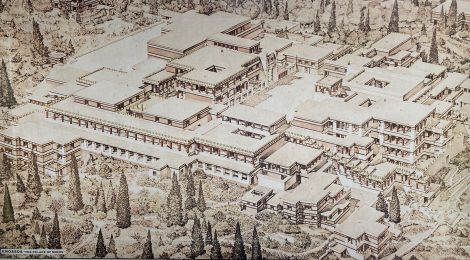
Visiting Knossos

Knossos was settled around 7000 BC, the oldest known settlement in Crete. Initially a hamlet of 25–50 people who lived in wattle and daub huts, kept animals, grew crops, and, in the event of tragedy, buried their children under the floor. From 6,000 to 5,000 BC it grew to house some 200-600 people. And from 5000–4000 BCE, housed 500–1000 people in more substantial family-private homes. The first Cretan palaces were built soon after c. 2000 BC, in the early part of the Middle Minoan period, at Knossos and other sites. These palaces were a notable uplift from the Neolithic mud-hut village system that had prevailed thus far. The building of the palaces demonstrates greater wealth and a concentration of authority, both political and religious. The religion at that time being mythical Gods. The greatest of which was Zeus. The God of Gods.
The palace of Knossos covered three acres with its main building and five acres when separate out-buildings are considered. With its 20,000 square meters, 1,300 rooms and 5 floors, it is the biggest Minoan building ever built. It had a monumental staircase leading to state rooms on an upper floor. A ritual cult centre was on the ground floor. The palace stores occupied sixteen rooms. Large storage jars up to five feet tall were used for storage of oil, wool, wine, and grain. The palace had bathrooms, toilets, and a drainage system. A theatre was found at Knossos that would have held 400 spectators including a rectangular orchestral area, used for religious dances and live entertainment.
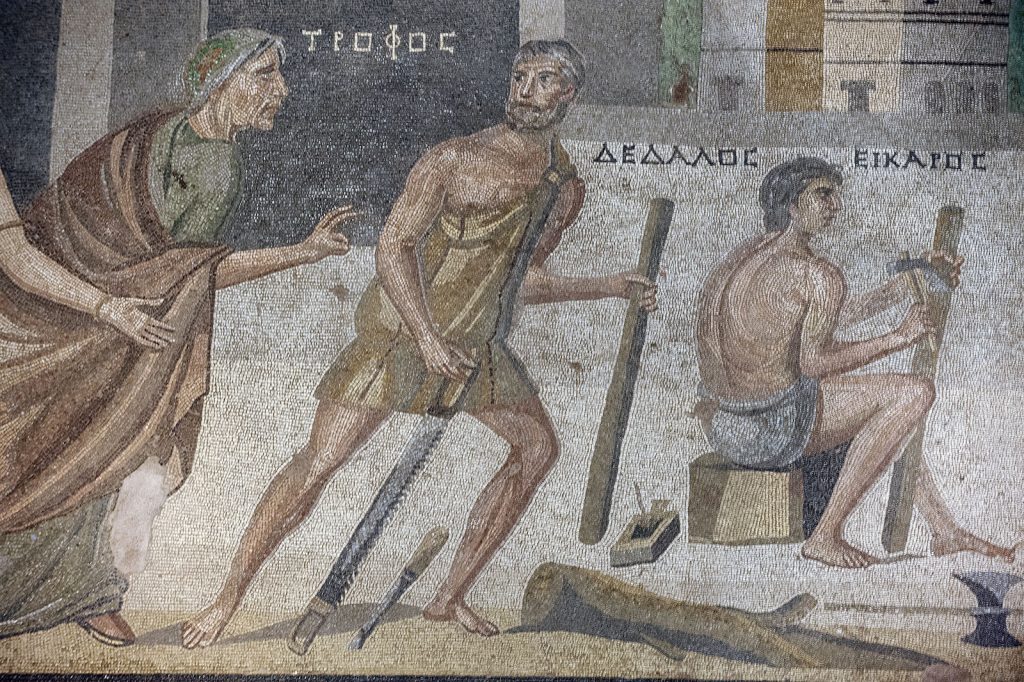
Daedalus is the central character in the legends of Knossos, a skillful architect and craftsman, seen as a symbol of wisdom, knowledge and power. He is first mentioned in roughly 1400 BC on the Knossian Linear B tablets. He is later mentioned by Homer as the creator of a dancing floor for Ariadne.
Daedalus was a big cheese in Athens at the same time that King Minos was doing good business building up his power as Cretan King of Knossos. Following some misfortune in Athens, Daedelus arrived in Crete, significantly improving King Minos’ strength with his smart engineering and design work.
What misfortune you ask?
Daedalus’ nephew, named variously as Perdix, Talos, or Calos, showed striking evidence of ingenuity. Finding the spine of a fish on the seashore, he took a piece of iron and notched it on the edge, thus inventing the saw. He put two pieces of iron together, connecting them at one end with a rivet, and sharpening the other ends, making a pair of compasses. In this envy-centric time of Greek culture, Daedalus became envious of his nephew’s accomplishments. His own status as the smartest guy in Athens threatened by this upstart, he decided to kill him by throwing him of the Acropolis.
Athena, the goddess of wisdom, warfare, and handicraft, intervened. She saved his nephew by turning him into a partridge. But Daedalus was busted, tried and convicted for this murder attempt. Running one step ahead of the law, Daedalus left Athens and fled to Crete where King Minos was all to happy to welcome this brilliant engineer and architect.

Minos was the King of Crete. His dad was Zeus. His mum, Europa, a Phoenician princess from Tyre Lebanon. (Europe is probably named after her.) When Zeus saw Europa he became enamoured.
He decided to seduce or rape her, the two being near-equivalent in Greek myth.
He transformed himself into a tame white bull and mixed in with her father’s herds. While Europa and her helpers were gathering flowers, she saw the bull and went to stroke its smooth buttocks. She was moved to sit on top of the bull, whereupon Zeus took that opportunity to run to the sea, swimming with her on his back to the island of Crete.

The first of the three children born of this union was Minos. King Minos first appears in Greek literature in the Odyssey and Iliad of Homer, although his character would have been well known centuries if not thousands of years before. It is from King Minos that Sir Arthur Evans named the civilisation of Knossos Minoan.
In Michelangelo’s famous fresco, The Last Judgment (located in the Sistine chapel), Minos appears as a judge of the underworld, surrounded by a crowd of devils. With his tail coiled around him and two donkey ears (symbol of stupidity), Minos judges the damned as they are brought down to hell (see Inferno, Second Circle).

After his death, Minos became a judge of the dead in Hades together with Aeacus and Rhadamanthus. Rhadamanthus judged the souls of Asians, Aeacus judged Europeans, and Minos had the deciding vote.
This iteration of Minos went on to become a most successful King. King Minos then gets married. His queen is Pasiphaë. Minos fathered eight children with Pasiphaë; Ariadne, Androgeus, Deucalion, Phaedra, Glaucus, Catreus, Acacallis, and Xenodice.
Minos then asks Poseidon, god of the sea, for some confirmation of his support. His request is for a beautiful snow-white bull. Poseidon agrees, however the Bull must be sacrificed to honour the gods. Minos decides not to.
Feeling slighted the God’s decide to punish Minos. They cause mother of eight Pasiphaë to feel uncontrollable sexual urges towards this snowy white bull. Unable to control these lustful urges, possibly connected to having had eight children, Pasiphaë tries to seduce the beautiful white bull. The bull is not interested. Rejected, Pasiphaë now goes to the smartest engineer in Crete for assistance.
Daedalus decides to help her sexual ambitions by designing a hollow wooden cow covered with real cow-skin, so realistic that it fooled the white bull. Pasiphaë climbed into the structure, allowing the bull to penetrate her, leading to pregnancy. Pasiphaë then gave birth to a half-human half-bull creature. The child was named Asterius, after the previous king, but was commonly called the Minotaur. “The bull of Minos”. He is a carnivore whose preference is human flesh.
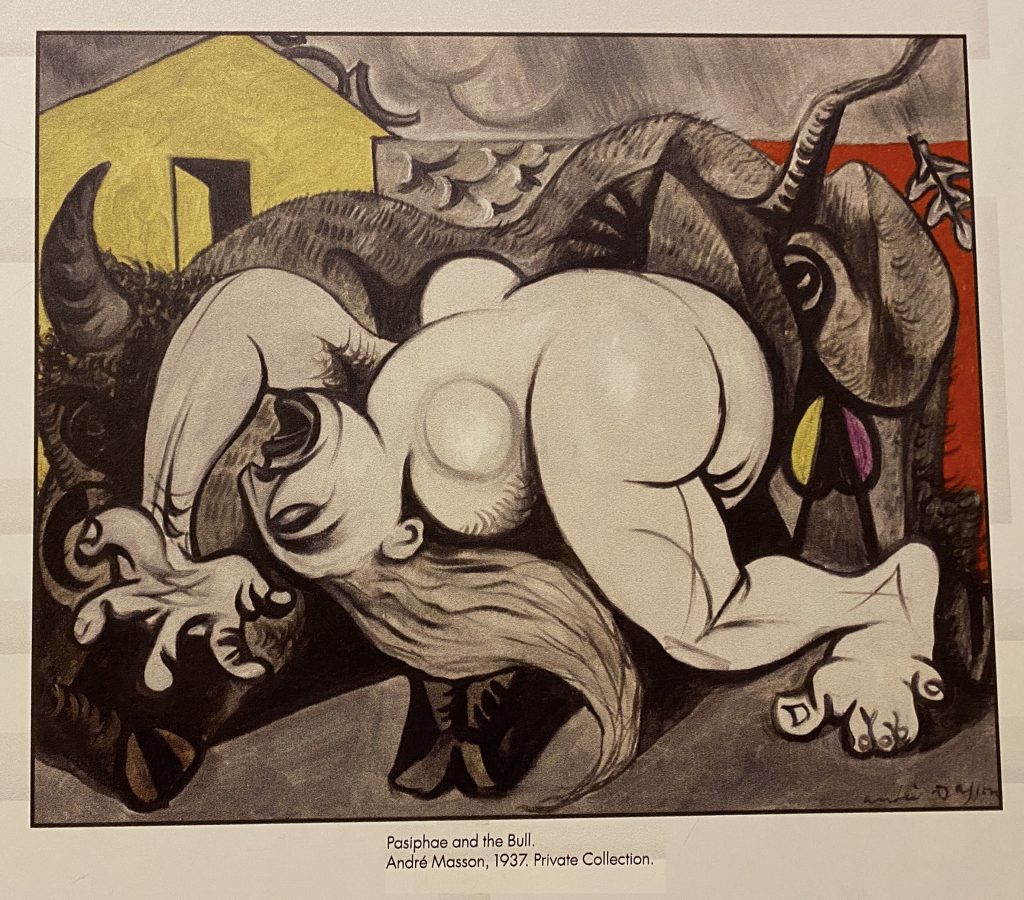
Minos has to decide how to house this fearsome Minotaur. He has Daedalus build a complicated “chamber that with its tangled windings perplexed the outward way”. He calls it a Labyrinth. Minos keeps the Minotaur in the labyrinth of Knossos, sending in human sacrifices to keep his wife’s illegitimate half-bull son fed.
The eldest child of Minos and Pasiphaë was, Androgeus. He was athletic. He competed in the Panathenaic Games, held in Athens every four years. Being strong and skillful, Andro did well, winning Gold in several events. He became a crowd favorite much to the resentment of the Pallantides, whose envy led them to assassinate Androgeus, incurring the wrath of Minos.
Minos then ordered the powerful Cretan fleet to set sail for Athens. Minos demanded Aegeus, the Athenian king, surrender his son’s assassins, saying that if they were to be handed to him, the city would be spared. King Aegeus was unable to find the assassins. They reached an agreement where Athens would send the seven most courageous youths and the seven most beautiful maidens as tribute to Crete, never to be seen again. A sacrifice to appease the God’s, in reality, just food for the Minotaur.
This shipment off fresh food would be expected once every eight years. And so, in ships with Black sails denoting their sorry purpose these 14 young people would leave Athens every eight years.
For some 16 years things continued as usual. On the third occasion of the black-sailed departure of 14 children from Athens to terrible death, the son of King Aegeus, Theseus volunteered to put an end to this madness, by dialogue if possible, by violence if necessary.
Theseus was a powerful character, growing up in Troezen, far from Athens. One day his mother told him the truth about his father’s identity and that he must take the sword and sandals back to the king, Aegeus, to claim his birthright.
To journey to Athens, Theseus could choose to go by sea, the safe way, or by land, following a dangerous path around the Saronic Gulf. On this route he would encounter six entrances to the Underworld, each guarded by a chthonic (relating to or inhabiting the underworld) enemy.
Young, brave, and ambitious, Theseus decided to go alone by the land route and defeated many bandits along the way. The six entrances to the underworld, more commonly known as the Six Labours, included these adventures for young Theseus.
At the first site, Epidaurus, Theseus turned the tables on the chthonic bandit, Periphetes the Club Bearer, who beat his opponents to death with a fearsome iron club. As his grandfather had already given him a description of Periphetes, Theseus immediately recognized him. In the savage encounter that followed Theseus paid back Periphetes in his own coin by dashing out the brains of the scoundrel with his own iron club. The brave youth kept the club as a trophy and soon reached the Isthmus of Corinth without further interruption.
His second challenge came at the Isthmian entrance to the Underworld. A robber named Sinis, often called “Pityokamptes” would capture travelers, tie them between two pine trees that were bent down to the ground, and then let the trees go, tearing his victims apart. Theseus slew him by his own method. With her father out of the way, Theseus, still a virgin, raped the daughter of Siris, named Perigune. Perigune would beget Theseus a son, Melanippus.
In his third deed north of the Isthmus, at a place called Crommyon, he killed an enormous pig, the Crommyonian Sow, bred by an old crone named Phaea. Possibly the sow was Phaea.
Fourth, near Megara, Theseus met a robber named Sciron, who forced travelers along the narrow cliff-face pathway to wash his feet. While they knelt, he kicked them off the cliff behind them, where they were eaten by a monster giant turtle. Theseus turned the tables on Sciron, pushing him off the cliff where he was eaten by the giant turtle.
Fifth came Cercyon, king at the holy site of Eleusis, who challenged passers-by to a wrestling match. When he had beaten them, Cercyon killed the loser. Theseus fought Cercyon at wrestling eventually beating him. He killed Cercyon by lifting him over his head dashed him to the ground. Theseus won owing to his skill, rather than superiority in brute physical strength. Theseus, in this way, started the sport of wrestling
The sixth and final challenge was the bandit Procrustes the Stretcher. Procrustes had a stronghold on Mount Korydallos at Erineus, on the sacred way between Athens and Eleusis. Procrustes had two beds, one of which he offered to passers-by. Once they accepted his gift of a bed for the night he then made them fit into it, either by stretching them, snapping their limbs of by enormous pulley pressure. Or by cutting off their feet to help them fit into the bed. Since he had two beds of different lengths, tall went in short beds and short in long beds. A cruel and cynical bandit. As was his way, Theseus once again employed Procrustes’ own method on him, cutting off his legs and then decapitating him with his axe. He killed Damastes Procrustes, by compelling him to make his own body fit his bed, as he had been wont to do with those of strangers. And he did this in imitation of Heracles. For that hero punished those who offered him violence in the manner in which they had plotted to serve him.
Now he was able to reach his Father in Athens and claim his birthright. Once established as heir to King Aegeus, Theseus next challenge was to confront the monster Minotaur in Knossos, to end this horror for the young in Athens.
Theseus took the place of one of the youths and set off with a black sail, promising to his father, Aegeus, that if successful he would return with a white sail. Like the others, Theseus was supposedly stripped of his weapons when they sailed, but he may have secreted a weapon among the folds of his tunic.
Arriving in Crete, Ariadne, King Minos’ daughter, took one look at this handsome young Athenian arrival and fell in love at first sight. Ariadne decided to help him in his mission to kill the Minotaur.
She took advice from Daedalus, the smartest man in Crete. Considering he was going into a labyrinth, she gave Theseus a ball of thread (a clew), so he could find his way out of the Labyrinth. Ariadne escorted Theseus to the Labyrinth, believing Theseus’s promise that if he returned from the Labyrinth alive he would take Ariadne with him to Athens, as his love.
When Theseus entered the Labyrinth he tied one end of the ball of string to the doorpost to mark his way back. It turned out he had hidden a sword from the guards, concealed inside his tunic. Theseus followed Daedalus’ instructions given to Ariadne: go forwards, always down, and never left or right. Theseus came to the heart of the Labyrinth and upon the sleeping Minotaur.
The beast awoke and a tremendous fight occurred.
Theseus overpowered the Minotaur with his strength and stabbed the beast in the throat with his sword (according to one scholium on Pindar’s Fifth Nemean Ode, Theseus strangled it).
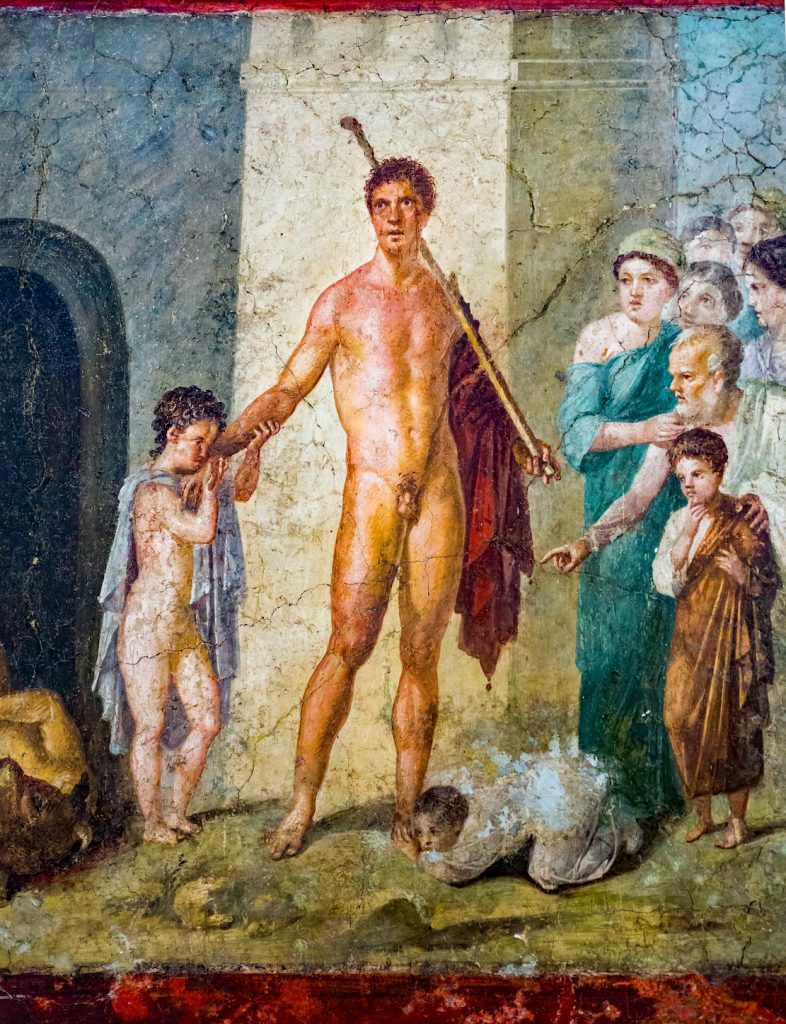
After decapitating the beast, Theseus used the string to escape the Labyrinth and managed to escape with all of the young Athenians and Ariadne as well as her younger sister Phaedra. Theseus and the rest of the crew fell asleep on the beach of the island of Naxos, where they stopped for water on their way back. Theseus then abandoned Ariadne leaving her heartbroken. Many paintings depict how heartbroken Ariadne was.
Dionysus eventually found Ariadne mourning in Naxos. He fell in love and married her.
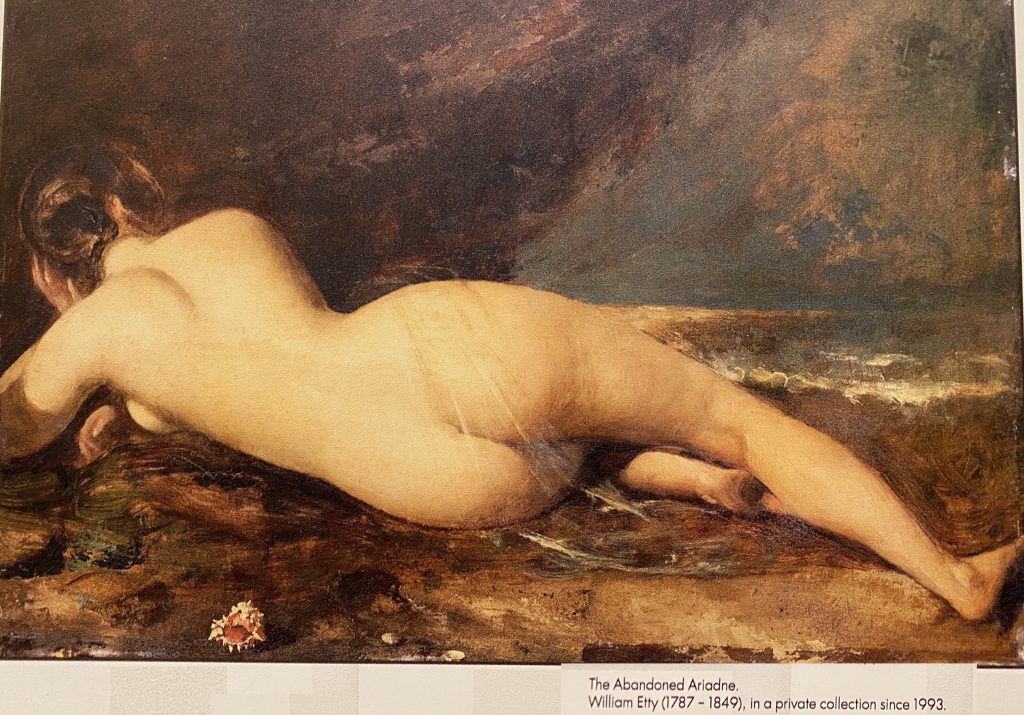
On his triumphant journey back to Athens, Theseus forgot to put up the white sails instead of the black ones. His father was watching the sea from a cliff of Cape Sounion. He saw the Black sail approaching. Believing his beloved Theseus had died in his brave effort to kill the Minotaur, Aegeus threw himself off the cliff into the sea, causing this body of water to be named the Aegean Sea.
The key man in this period of mythology is certainly Daedalus; widely praised as an inventor, artist, and architect, though classical sources disagree on which inventions exactly are attributable to him.
In Pliny’s Natural History (7.198) he is credited with inventing carpentry, including tools like the axe, saw, glue, and more. Supposedly, he first invented masts and sails for ships for the navy of King Minos. He is also said to have carved statues so spirited they appeared to be living and moving. He designed the cow deceit, to fool the beautiful snow white bull into having sex with Pasiphaë.

Daedelus designed the Labyrinth to house the Minotaur, and was responsible for the amazing architecture of Knossos, the most advanced of its time. After designing the labyrinth, King Minos imprisoned Daedalus, for security reasons, to prevent him disclosing the secrets of this elaborate prison for his wife’s bastard half-bull son.
After Theseus and Ariadne eloped together, having helped Ariadne with advice on how to locate the Minotaur, Daedalus and his son Icarus were imprisoned by King Minos in the labyrinth that he had built. He could not leave Crete by sea, as King Minos kept a strict watch on all vessels, permitting none to sail without being carefully searched.
In order to escape from King Minos, Daedalus set to work to make wings for himself and his son Icarus. Using bird feathers of various sizes, thread, and beeswax, he shaped them to resemble a bird’s wings.
When both were prepared for flight, Daedalus warned Icarus not to fly too high, because the heat of the sun would melt the beeswax holding his feathers together, causing the wings to fail. Equally, Icarus should not fly too low, because the sea foam would soak the feathers and make them heavy causing catastrophic failure to stay airborne.
Initially their escape was going well. Daedalus and Icarus had passed Samos, Delos, and Lebynthos, when the immature and over confident Icarus disregarded his fathers advice, gaining too much altitude. Icarus flew too close to the sun. The heat caused the wax that held the feathers together to melt. The wings detached. Icarus kept flapping his “wings” slow to realize he he was only flapping featherless arms. The feathers (one by one) fell like snowflakes, and down he fell. His death spiral, plummeting into the sea, where he sank and drowned.
Seeing Icarus’ wings floating on the sea, Daedalus wept, cursed his art, and finding Icarus’s dead body on an island shore, buried Icarus’s body there. He named the island Icaria in the memory of his child. The southeast end of the Aegean Sea where Icarus fell into the water was also called “Mare Icarium” or the Icarian Sea.
In a twist of fate, a partridge, presumably the nephew Daedalus murdered, mocked Daedalus as he buried his son. The fall and death of Icarus possibly punishment for Daedalus’s envy-based murder of his brilliant nephew in Athens.
At least two locations are associated with the death of Daedalus. One version has him retiring to the Cretan colony of Telmessos, ruled by Minos’s estranged brother Sarpedon,. There while hiking outside the city Daedalus was bitten by a snake and died. A life filled with rich experiences that included the joy of marrying Minos’ beautiful daughter Ariadne, and the sorrow of seeing his son Icarus die while test flying his wing-design.
After Daedelus’ escape from Knossos using his wing design, he made it to Sicily where he was welcomed by King Cocalus. Angry King Minos tracked him down there. This turned out to be a big mistake. Minos was killed by the daughters of King Cocalus, who poured boiling water over him as he was taking a bath, to protect Daedalus. Glorious King Minos was buried there. The Cretans who sailed with him founded colonies in Sicily and Southern Italy, naming one Minoa in honor of their King.
Theseus’ returned triumphant to Athens after abandoning Ariadne. His life of adventure continued. He was known as great abductor of women.
Theseus and his bosom companion, Pirithous, both sons of Zeus and Poseidon, pledged themselves to marry daughters of Zeus. Theseus chose Helen, said to have been the most beautiful woman in the world, believed to be the daughter of Zeus and Leda. Together the two buddies kidnapped Helen, aged nine at this time, intending to keep her until she was old enough to marry.
Pirithous chose Persephone, even though she was already married to Hades, king of the underworld. They left Helen with Theseus’s mother, Aethra at Aphidna, whence she was rescued by the Dioscuri.
Unwisely these two friends then traveled to the underworld, domain of Persephone and her husband Hades. As they wandered through the outskirts of Tartarus, Theseus sat down to rest on a rock. There he felt his limbs change and grow stiff. He tried to rise but could not. He was fixed to the rock. As he turned to cry out to his friend, he saw that Pirithous too was crying out.
Around him gathered the terrible band of Furies with snakes in their hair, torches, and long whips in their hands. Before these monsters, the hero’s courage failed and he was led away to eternal punishment. For many months in half-darkness, Theseus sat immovably fixed to the rock, mourning for both his friend and for himself.
Eventually he was rescued by Heracles who had come to the underworld for his 12th task. Cerberus is often referred to as the hound of Hades. He was a multi-headed dog guarding the gates of the Underworld to prevent the dead from leaving. Cerberus was the offspring of the monsters Echidna and Typhon, and was usually described as having three heads, a serpent for a tail, and snakes protruding from multiple parts of his body. Cerberus is best known for his capture by Heracles in the last of Heracles’ twelve labours.
After his rescue by Heracles Theseus persuaded Persephone to forgive him for the part he had taken in the rash venture of Pirithous. Now Theseus was restored to the upper air but Pirithous never left the kingdom of the dead. Heracles tried to free Pirithous, but the underworld shook. Convinced the task was beyond any hero they left.
Sadly when Theseus returned to Athens he found that the Dioscuri had taken Helen and Aethra to Sparta.
Theseus was the great hero of ancient Athens. The numerous heroic deeds ascribed to him were seen by the ancient Athenians as the acts that led to the birth of democracy in the Attic city-state, the cradle of Greek democracy. Since he is portrayed as the contemporary of Hercules, it is likely he belonged to the generation previous to the Trojan War. His grand exploits against vicious villains and dreadful monsters are said to be an allegorical representation of how Theseus got rid of the tyrants, got the Athenians free from fear and brought an end to the burdensome tribute the city had to pay to foreign powers.
After the death of his Amazonian wife Antigone, Theseus had married Phaedra, the sister of Ariadne, the woman he had once betrayed. Phaedra bore two sons, Demophone and Acamas.
Meanwhile Theseus’ son by the Amazon Antigone, Hippolytus, had grown into a handsome youth. Hippolytus was a hunter and sportsman. He was disgusted by sex and marriage. In consequence, he scrupulously worshipped Artemis, the virgin huntress, and refused to honor Aphrodite. Offended by this rebuttal Aphrodite caused Phaedra, Hippolytus’ stepmother, to fall madly and deeply in love with her handsome but sexually-unavailable stepson.
Phaedra falls so ardently in love with Hippolytus that she becomes physically ill and decides to end her suffering through suicide. Her nurse tries to save her by revealing the secret to Hippolytus and encouraging him to reciprocate. Hippolytus responds with horror and disgust, humiliating Phaedra.
In despair, and not wanting to admit the true reason for ending her life, she hangs herself and leaves a note for Theseus accusing his son, Hippolytus, of raping her.
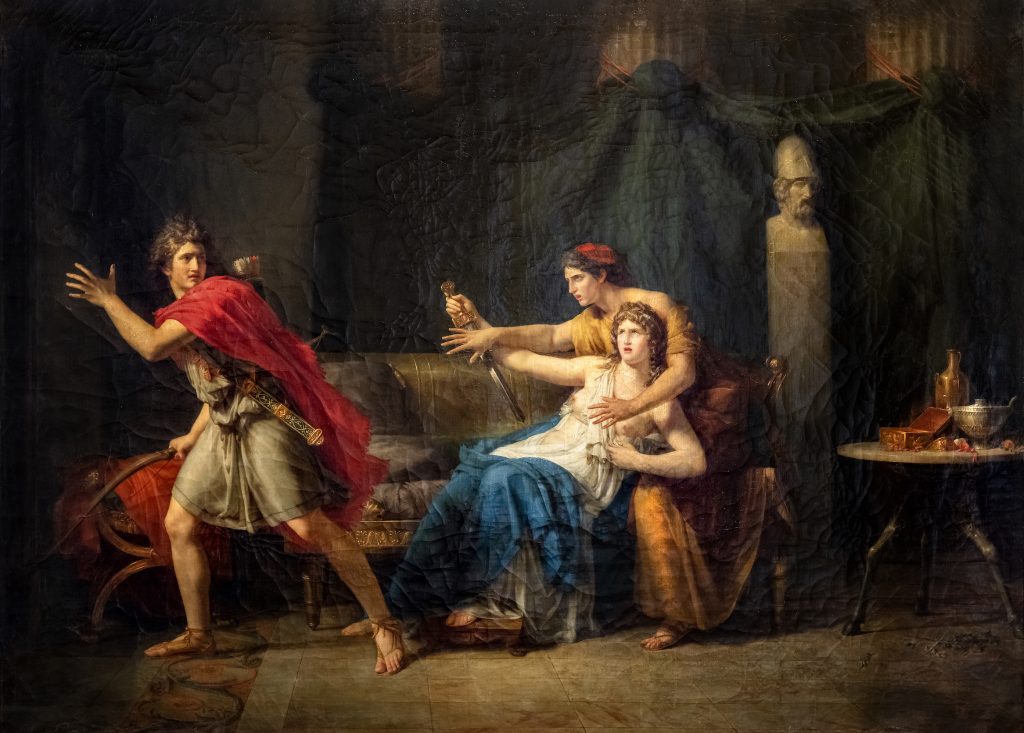
Theseus-the-furious uses one of the three wishes given to him by Poseidon, his father. Theseus calls on Poseidon to punish Hippolytus, who has fled the palace to go hunting. Poseidon sends a sea-monster to terrorize Hippolytus’ chariot horses. The horses bolted, overturning the chariot, dragging the youth trapped in the reins. He suffers grievous life treating painful injury.
Meanwhile, Theseus, had learned the truth from a servant of Phaedra. He rushed to save his son’s life, only to find him mortally wounded. Hippolytus then expires in the arms of his grief-stricken father.

This incident was the beginning of end for Theseus, who was losing his popularity among the Athenians. His former heroic deeds and services to the state were forgotten and rebellions began to surface all around against his rule.
Theseus finally abdicated his throne and took refuge on the island of Skyros. There Lycomedes, the king of the island, thought that Theseus would eventually want to become king of Skyros. In the guise of friendship he invited Theseus for a walk along the top of a cliff, surprising him with a push off the cliff into the sea far below. A tragic end of the life of one of the most celebrated Athenian heroes. The man who killed the Minotaur and won so many challenges by valorous endeavor dead by cliff fall. Just like his father Aegeus at Cape Sounion.
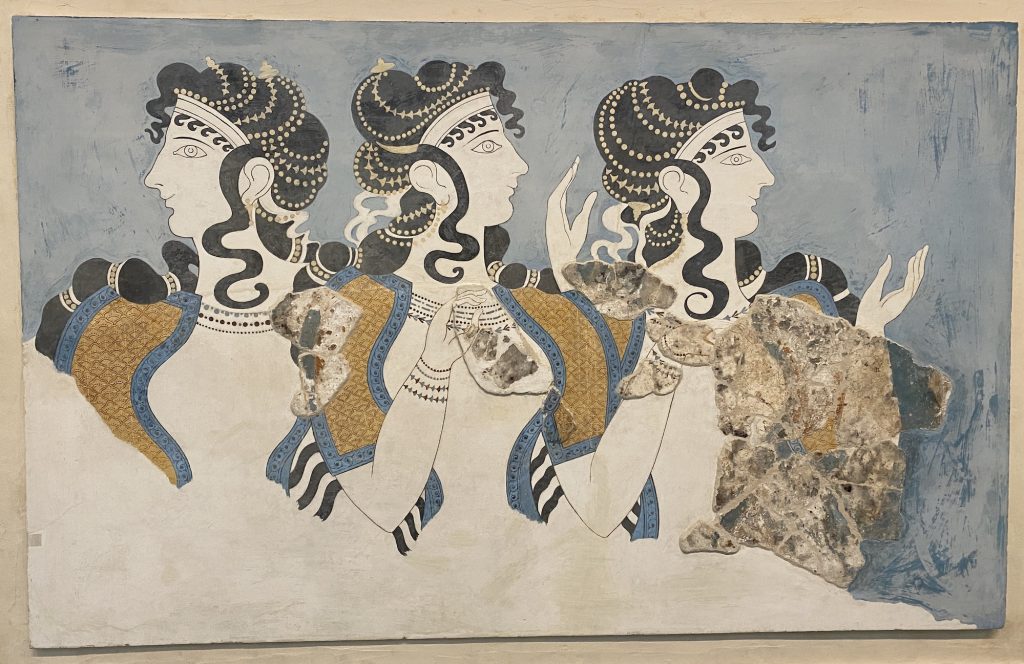
Amazon Bookstore for Paperback and Kindle
Apple Books on EPUB here
My Paypal Patrons support is here

Comments are closed, but trackbacks and pingbacks are open.